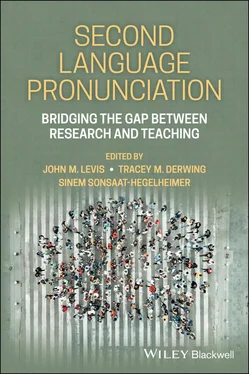Second Language Pronunciation
Здесь есть возможность читать онлайн «Second Language Pronunciation» — ознакомительный отрывок электронной книги совершенно бесплатно, а после прочтения отрывка купить полную версию. В некоторых случаях можно слушать аудио, скачать через торрент в формате fb2 и присутствует краткое содержание. Жанр: unrecognised, на английском языке. Описание произведения, (предисловие) а так же отзывы посетителей доступны на портале библиотеки ЛибКат.
- Название:Second Language Pronunciation
- Автор:
- Жанр:
- Год:неизвестен
- ISBN:нет данных
- Рейтинг книги:5 / 5. Голосов: 1
-
Избранное:Добавить в избранное
- Отзывы:
-
Ваша оценка:
- 100
- 1
- 2
- 3
- 4
- 5
Second Language Pronunciation: краткое содержание, описание и аннотация
Предлагаем к чтению аннотацию, описание, краткое содержание или предисловие (зависит от того, что написал сам автор книги «Second Language Pronunciation»). Если вы не нашли необходимую информацию о книге — напишите в комментариях, мы постараемся отыскать её.
Second Language Pronunciation: Bridging the Gap Between Research and Teaching
Second Language Pronunciation: Bridging the Gap Between Research and Teaching
Second Language Pronunciation — читать онлайн ознакомительный отрывок
Ниже представлен текст книги, разбитый по страницам. Система сохранения места последней прочитанной страницы, позволяет с удобством читать онлайн бесплатно книгу «Second Language Pronunciation», без необходимости каждый раз заново искать на чём Вы остановились. Поставьте закладку, и сможете в любой момент перейти на страницу, на которой закончили чтение.
Интервал:
Закладка:
L2 pronunciation
Proponents of the Critical Period Hypothesis (CPH) argued that L2 speech learning is fundamentally different from L1 speech development. In their view, the mechanisms used in L1 speech learning are no longer available, and instead, L2 learners must rely on general learning mechanisms, which are not optimized for speech (Scovel, 2000). While the CPH was once an appealing explanation for why adult L2 learners rarely achieve nativelike pronunciation, no clear empirical evidence has been found to support it. In contrast, strong evidence now favors a more nuanced understanding of L2 pronunciation development. Flege et al. (1995a, 1995b) investigated the L2 English pronunciation of Italian immigrants to Canada who had arrived at a range of ages from early childhood to adulthood. They found no critical biological period after which the ability to acquire a nativelike accent precipitously declined. Instead, the relationship between age of arrival and strength of foreign accent was found to be linear. Therefore, while these studies provide evidence that it is better to learn L2 pronunciation at a younger age, they appear to falsify the CPH’s claim, that the learning mechanisms used in L1 acquisition are lost during brain lateralization. Flege et al. (1997) later established that the strength of individuals’ L2 accent is also strongly correlated with the quantity of their L2 experience and the extent to which L2 learners continue to use their L1s in everyday life. Taken together, this evidence suggests that the perceptual mechanisms utilized in L1 learning remain intact over the lifespan, but that accessing them becomes increasingly difficult. L2 learners are no longer a blank slate but come to the task with established L1 categories and typically fewer opportunities to obtain impactful experience with the L2 (Flege, 1995; Flege & Bohn, 2021).
It appears, then, that the automatic nature of L1 speech perception after the age of four is what most conspires against adults easily accessing speech learning mechanisms. Unfortunately, after these perceptual processes have become automatic, it is difficult to notice the phonetic-level information needed to categorize sounds in a new language. Instead, L2 sounds are automatically filtered through L1 perceptual categories. Best and Tyler’s (2007) Perceptual Assimilation Model (PAM) and Flege’s (1995, see also Flege & Bohn, 2021 for an update) Speech Learning Model (SLM) are the most often-cited explanations of L1 influences on L2 learning. Both argue that the relative dissimilarity of L1 and L2 speech sounds predicts how easy it will be for L2 learners to acquire sound categories in a new language. When L1 and L2 speech sounds are identical, or nearly so, a simple substitution will suffice. Nothing needs to change regarding the automatic processing for such sounds. When an L2 sound is unlike any sound category in the learner’s L1, new category development is also likely to occur, but it may take some time. The greatest challenge in L2 pronunciation learning presents when one or more dissimilar L2 categories are perceptually assimilated to a single L1 category. For example, a Japanese L2 English learner may perceive both English /l/ and /ɹ/ to be equivalent to a single Japanese apico-alveolar tap /ɾ/. This misperception of two contrasting English categories causes Japanese speakers to substitute their /ɾ/ sound for both English /l/ and /ɹ/. It happens to be the case that despite the Japanese category not being a perfect example of English /l/, English L1 listeners perceive it to be closest to their /l/ category, and perceive it as such. This results in English L1 listeners recognizing Japanese attempts to pronounce English /l/-/ɹ/ word pairs as homophonous (e.g., their renditions of “right” and “light” are both perceived as foreign-accented versions of “light”). Similar assimilation patterns occur for learners of other L2s. For example, English learners of a Hindi alveolar and retroflex stop contrast typically assimilate both Hindi categories to English /t/ (Guion & Pederson, 2007).
In the case of the English /l/-/ɹ/ contrast, acoustic information needed to discriminate these sounds is tuned out by Japanese L1 speakers, since it has no importance in their language (Brown, 1998). Similarly, English L1 learners of Mandarin tonal contrasts cannot easily recognize tonal distinctions because pitch cues associated with Mandarin tones are not used in the same way in English (Guion & Pederson, 2007). In sum, the primary source of difficulty in L2 pronunciation development is learners’ inability to reorient attention to phonetic information that they have learned to ignore (Chang, 2018). The processing efficiency that was an advantage to L1 learning has now become an impediment in L2 learning. To successfully learn L2 sounds, learners must re-educate this selective perception (Strange & Shafer, 2008). In the next section we will see that this is indeed possible.
Critical Issues
While L2 pronunciation development follows similar paths in both naturalistic and instructed learning contexts, what learners ultimately achieve varies. In naturalistic environments, perceptual processes remain largely automatic until there is a breakdown in communication, which may alert learners to problems with their perception of a sound. In contrast, instructed pronunciation learning affords more opportunities for teachers to explicitly orient learners’ attention to mismatches and to provide them with more attention-orienting input.
Naturalistic L2 Pronunciation Development
As in L1 learning, L2 pronunciation naturalistically develops through experience with the ambient language. During the very earliest phases of adult L2 learning, aural and/or written input typically predominate as models for pronunciation. Unlike L1 learning, however, adult L2 learners are already effective communicators in one language and aspire to quickly experience similar success in their L2. This typically means that they will fail to develop accurate L2 perception before hastening to produce L2 speech. Their own productions then become the primary input to their new L2 system (Schmidt & Frota, 1986). Interestingly, younger L2 learners often go through a self-imposed silent period when first immersed in an L2 environment (Ervin-Tripp, 1974), lasting for up to six months (Winitz et al., 1995). This parallels the pattern observed in infant L1 phonological development, and at least in experimental conditions, appears to benefit learners’ pronunciation skills (Trofimovich et al., 2009). Trofimovich et al. argue that adult learners’ L2 pronunciation does not benefit from a similar silent period, but they provide no evidence to support this claim. Rather, it seems they view a silent period to be an impractical and unnecessary delay to adult learners’ ultimate social and employment goals.
Despite the fact that adult L2 learners attempt to speak before they have much experience with the perception of L2 sounds, there remains a short lag between improvement in perception and corresponding improvement in production. Summarizing the literature, Thomson (2022) reports that L2 perception scores are typically higher than L2 production scores for the same sound categories. Some counter-examples of L2 production accuracy surpassing perceptual accuracy do exist (Goto, 1971). However, most cases come from researchers whose explicit aim is to disprove the claim that perception precedes production (e.g., Borden et al., 1983; Bradlow et al., 1997; Sheldon & Strange, 1982). As Thomson (2022) notes, the reading task used to elicit speech in these studies allows learners to apply explicit knowledge of how to produce words based on spelling. Consequently, it is a strategy for bypassing natural progression, rather than proof that production can otherwise precede perception. There is also no evidence that such a strategy would extend to spontaneous communicative contexts.
Читать дальшеИнтервал:
Закладка:
Похожие книги на «Second Language Pronunciation»
Представляем Вашему вниманию похожие книги на «Second Language Pronunciation» списком для выбора. Мы отобрали схожую по названию и смыслу литературу в надежде предоставить читателям больше вариантов отыскать новые, интересные, ещё непрочитанные произведения.
Обсуждение, отзывы о книге «Second Language Pronunciation» и просто собственные мнения читателей. Оставьте ваши комментарии, напишите, что Вы думаете о произведении, его смысле или главных героях. Укажите что конкретно понравилось, а что нет, и почему Вы так считаете.












